7 Steps for Effective PR Crisis Management in 2025 [Infographic]
Table of contents
PR crisis. We are all frightened of it. In an ideal world, a well-managed company wouldn’t have to worry about such a thing. Unfortunately, we don’t live in a perfect world. The question is not if a crisis will strike but when it will happen.
PR crisis management is critical for your brand’s reputation during challenging times. It involves immediate and strategic responses to minimize negative perceptions. Effective crisis management includes continuously monitoring media channels to understand public sentiment and craft relevant messages.
Public Relations crisis management rules are general rules that help organizations manage their presence during such a pressure situation.
To make the complicated process a bit more digestible, we divided the communications and management rules into three steps:
- Pre-crisis management
- Crisis management
- Post-crisis management
That way, you will know how to act along every step of the way.
What is Public Relations crisis management?
It is the process of preparing an organization for a major event that threatens its business reputation, stakeholders, or the general public.
Public relations professionals play a vital part in crisis communication.
During a crisis, the main goal of a PR department would be to inform all interested parties about the current situation, potential risks, and planned actions. A well-prepared crisis plan should contain the first type of message that will be sent out to the world.
This generic message should restore trust in your organization and give you some time to investigate the issue at hand.
The public relations and marketing team is the first line of defense for your company. Whether you leave the crisis unscathed depends mainly on how well you handle Public Relations crisis management.
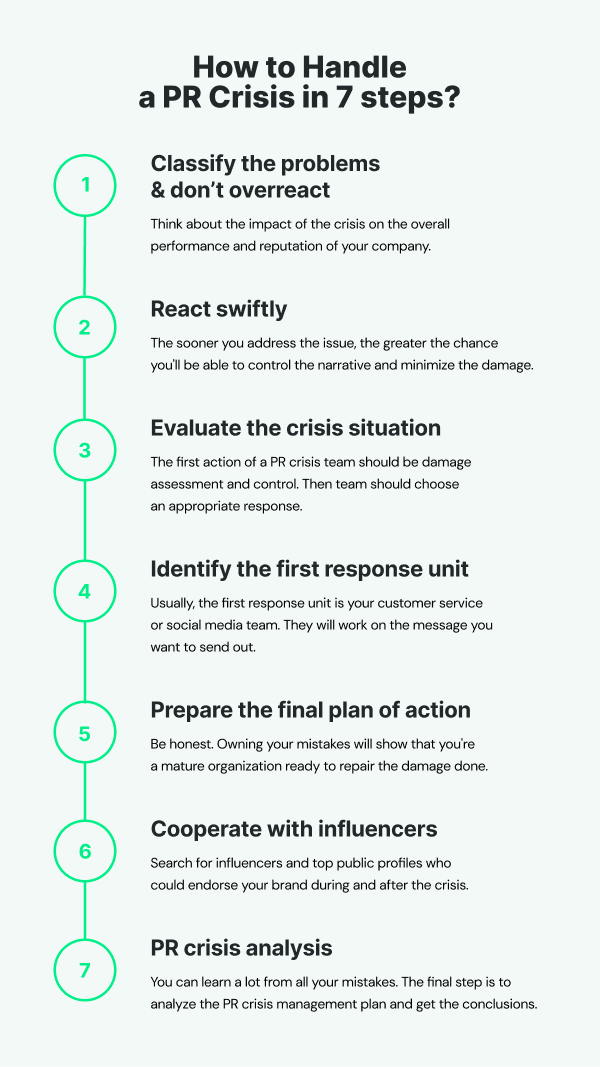
When should you react to PR crises?
First of all, you need to know when and how to react.
So, let’s deal with “when” first.
Not every negative comment constitutes a Public Relations crisis that could damage your brand reputation and requires your CEO’s involvement. The real, big problem appears when a mishap spreads in business news.
You can implement a triage technique to assess the severity of the potential PR disaster. Assessing the problem early will help you manage the situation and not waste any resources on unnecessary actions.
You have to give any situation you consider threatening the right color: green, orange, or red.
Green tag
Green is for situations that don’t require any immediate actions from your organization. For example, when one of your competitors faces a crisis, that doesn’t necessarily affect your business.
There is a chance, though, that it will impact your business in some way. Monitor the situation closely and send in your crisis response team when needed.
Take a closer look at Google search results. If you see your company trending in the media, the tag can change from green to orange.
Orange tag
The orange tag is for situations that could possibly harm your business and destroy your consumers’ trust in your brand.
Think about one negative review out of hundreds of positive comments. You should keep an eye on it, but don’t summon your PR crisis team just yet.
Red tag
Red is when you have to act quickly and decisively. Your business reputation and revenue are in imminent danger, and you have to call in your PR response team.
Code red includes situations that could damage your brand reputation or disturb supply chains. These types of crises could potentially negatively affect the bottom line of your business.
The harshest types of crises usually include an executive scandal or, unfortunately, some form of sexual harassment. You want to tackle this type of PR issue quickly. Preferably, before your audience and the press get a sniff of a scandal.
Remember that situations can escalate quickly and go from code green to orange or even red in a couple of hours. That’s why it’s essential to monitor the situation constantly.
Prevent PR crisis!
How to prepare for a PR crisis?
There’s bad news, and there’s good news.
The bad news is, there is a high chance that a crisis will hit your organization someday.
The good news is, you can prepare a crisis communications plan for your business and minimize the damage.
I am sure you already have a solid PR strategy. But what about the approach that will help you control PR crises? Having a robust Public Relations crisis strategy in place will ensure your employees know what to do.
Here’s what you have to take into account while preparing your crisis plan!

Discover our client’s success story — read the case study.
Monitor news cycle around your brand
We live in a world that’s always online. Social media allow everyone to publish opinions or reviews.
Probably, the crisis will begin online on communication channels that you do not own. That’s a worst-case scenario because your audience will spot the crisis before your PR team.
Unnoticed PR crises can easily escalate and affect the bottom line of your business.
To prevent an escalation of an online crisis, you have to be aware of what people say about your company or product.
The proliferation of online channels makes it impossible to track all online mentions regarding your brand online.
A simple solution is a media monitoring and analysis tool. For example, Brand24 gathers publicly available online mentions containing your predefined keyword.
Brand24 offers much more than just a collection of online posts. The tool will also analyze the mentions. You can tag them according to your needs, so you get the most important information analyzed.
From a crisis stewardship perspective, which features of a media monitoring tool are the most relevant?
Let’s go through the list one by one!
Sentiment analysis & the volume of mentions
A social listening tool will automatically assign a sentiment to the collected online mentions.
You will see whether the talk about your brand is positive, negative, or neutral.
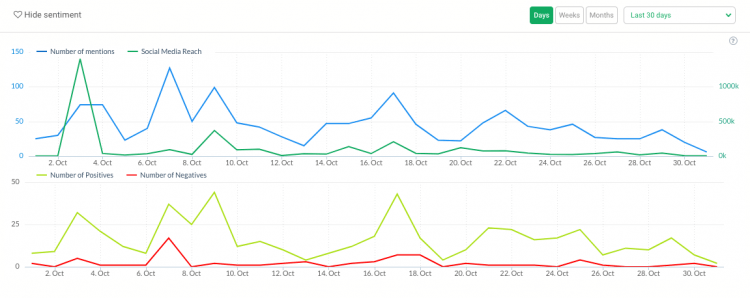
To get the most out of media monitoring and PR sentiment analysis, combine the metric with the volume of mentions.
The volume of mentions is the total number of mentions within a defined timeframe.
A spike in the number of mentions and prevailing negative sentiment indicates a PR crisis in the making. Monitor the metrics closely to react before the press spot your problems.
On the other hand, a spike of positively marked mentions means you’re doing a great job!
Filters
If you’re monitoring mentions around a large company or popular product, you’ll receive a ton of mentions.
They all might be relevant to your project, but you might need to examine only some part of the online chatter.
To help you with that task, we develop a handful of filters you can use in your project.
Here’s the list of filters that you can find in the dashboard:
- Country
- Interactions
- The number of visits
- Domain
- Public profile
- Date
- Brand Sentiment
Which filters are useful when it comes to crisis management?
For sure, you have to take into account the number and type of interactions and the number of visits.
This will help you assess the pace at which the news spreads online and whether the content is getting traction with other users.
The domain filter will help you pinpoint the earned channels where your company is popular. It doesn’t necessarily mean you should invest in a profile on the platform, but you should monitor where the conversation is headed.
Filtering by public profiles can help you spot any influential public profiles talking about the company you’re interested in.
Their posts tend to attract high levels of attention, so it’s vital to know whether some of them are posting about your brand.
Prevent PR crisis!
AI Anomaly Detector
The Anomaly Detector is like that one friend who always spots the smallest signs of something big coming.
It detects unusual spikes in discussions about your brand across media platforms. By catching these early, your team can look into issues before they grow.
This helps you respond quickly to negative talk and keep control of your brand’s story.
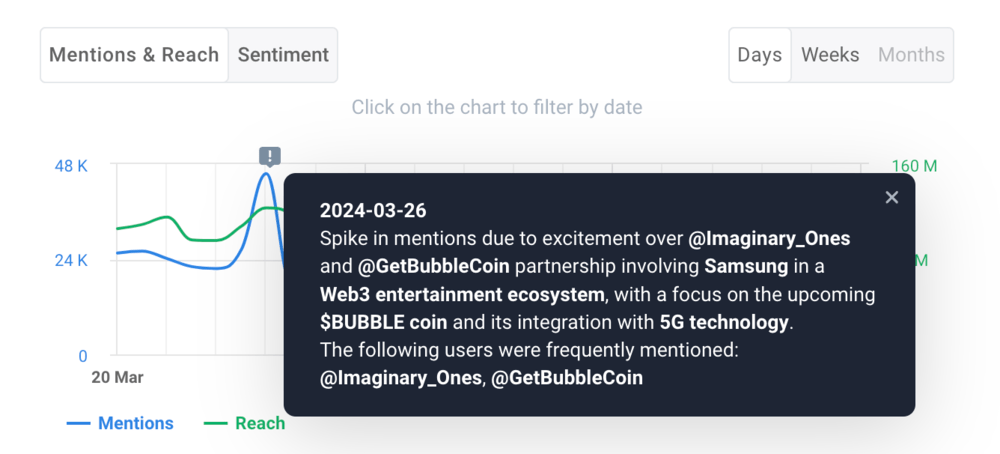
Notifications
To be able to prevent a PR crisis from spreading, you have to be aware of it.
That’s why you need a robust notifications system. Brand24’s notifications allow you to receive all mentions or already filtered ones.
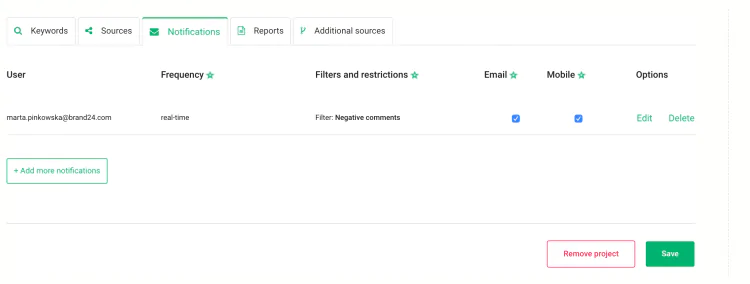
In Brand24, we offer three types of notifications that will help you manage a PR crisis:
- Slack notifications. That’s my personal favorite. Every time there’s a new mention in the dashboard, you’ll receive a Slack notification. That way, you can stay up to date all the time.
- Email notifications. If you don’t have access to Slack, you can opt for email notifications. You can receive real-time, hourly, every six hours, every 12 hours, daily, weekly, or monthly alerts.
- In-app notifications. Brand24 offers app both for iOS and Android. You can see all the mentions from your projects right on your phone.
Negativity Source
You can find this AI feature in the Metrics Analysis section.
This chart shows the amount of negative mentions by source. Identifying which source is the most negative can help you see if your efforts to manage a crisis are working.
With this chart, you can make better decisions during a crisis, ensuring your actions are based on clear data.

Always be prepared
You might think that your product is superb and your organization works smoothly. That doesn’t mean you’re immune to crisis.
Nowadays, the question is not if a PR disaster hits you but rather when it will happen.
That’s why you should have a crisis response plan in place. No matter when a crisis occurs, every member from all strategic departments within your company will know how to react and what to do.
The crisis communication plan could also help new employees that join your company during a PR turbulences. The new hires will immediately know how to act and what’s the company strategy in a time of crisis.
Track mentions about your brand!
How to handle a Public Relations crisis in 7 steps?
Having a crisis communication strategy prepared is important, but apart from the theory, it is crucial to know how to react when the catastrophe actually occurs. If you have second thoughts about the best ways to handle a PR crisis, we created a list of 7 steps to help you get through tough times.
These are our best practices. Stick to them, and you will indeed have it under your control.
1. Classify the problems & don’t overreact
Not every negative remark about a brand constitutes a PR mishap. That doesn’t mean you shouldn’t respond to negative statements.
Just don’t involve your CEO in response to a negative Google review.
Think about the impact of the crisis on the overall PR performance and reputation of your company.
Some problems will go away on their own. Reacting to the negative message can give traction and focus your audience on a problem.
Sometimes, when it comes to reputation management, doing nothing is the best possible option.
2. React swiftly
Once you know you’re dealing with a PR crisis situation, you have to act fast.
Time is of the essence.
The sooner you address the issue, the greater the chance you’ll be able to control the narrative and minimize the damage.
People expect a response in no time. There won’t be time to craft some well-thought reply.
That’s why you should prepare some generic answers that you can publish right away or twitch just a bit.
Think about the social media channels that will work for your company. You can publish a statement on your company’s Facebook page, write an article or blog post, or record a video.
Find a communication channel that works for your customers and other stakeholders.
The goal is to give an impression you have the situation under control. There will be time for more detailed explanations later in the process.
3. Identify the first response unit
You need to train your employees, so they know what to do and how to act.
It’s vital to point to the right employees and clearly define their responsibilities. Even the best team will be clueless if they don’t know who should perform certain tasks.
Usually, the first response unit is your customer service or social media team.
Customer service has the privilege of talking directly to your customers. They can spot any PR issues before they reach a wider audience, for example, the press.
A potentially viral negative opinion can appear on one of the social media channels. If the threatening mention is picked up by one of your communication specialists, there is still time to protect your organization’s reputation.
If the crises escalate, you need a holistic team you can trust. You should include different members of your organization, such as:
- CEO
- Person with legal knowledge
- Person responsible for communication with the media
- Person responsible for communication with other stakeholders
- Person responsible for communication with customers
- Someone with technological knowledge
The team will work on the message you want to send out, manage press releases, and try not to lose the trust of your customers.
This will ensure that your crisis communications efforts will run smoothly and everyone will be at the right place at the right time.
Understand your audience better!
4. Evaluate the crisis situation
The trained personnel should assess the PR mishap situation and act accordingly.
Every PR crisis requires a different approach and reaction.
That’s why the first action of a PR crisis response team should be damage assessment and control.
Depending on a PR crisis’s size and possible implications, the team should choose an appropriate response.
After the team decides what to do, they should start counteracting the effects of a crisis.
5. Prepare the final plan of action
You have the holding statements that should buy you some time. Now, it’s time to prepare the final plan of action.
Your response will depend on your industry. There are, however, some general rules you should obey.
For starters, be honest. Of course, you want to minimize the damage, but denying the crisis, shifting blame, or omitting the details will only worsen the crisis.
Owning your mistakes will show that you’re a mature organization ready to repair the damage done.
6. Cooperate with influencers
Once your brand, product, or service is under fire, you should look for people who can vouch for it.
That’s why you should take a look at influencers and top public profiles who could endorse your brand during and after the crisis.
The key to a successful influencer campaign is to choose the right person to work with. The most suited influencers are probably already talking about your brand.
A media monitoring tool will help you find the best influencers to help you deal with a PR mishap.
Once you log into your project, go to the Analysis tab. There, you can find two tables – the most popular public profiles and the most active public profiles.
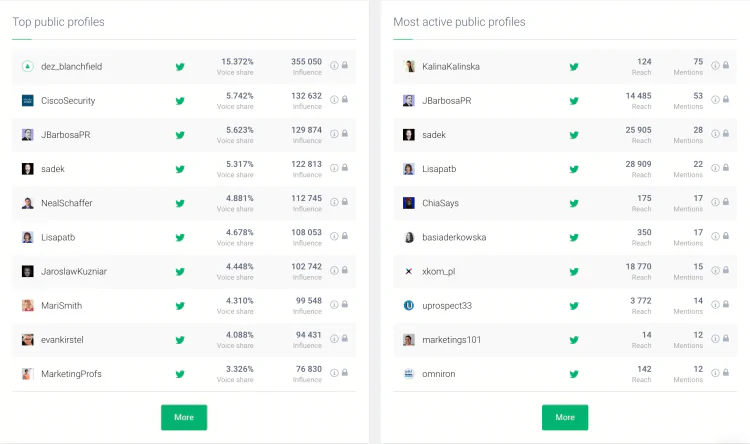
Of course, you still have to vet the names. Examine what type of content do they post, how the engagement looks like under their posts, and on which social media platforms they are active. Based on the analysis, choose the right influencer to endorse your brand.
Read also the best Pr monitoring tools.
7. PR crisis analysis
The final step is equally important as the previous ones. Remember that you can learn a lot from all your mistakes.
That’s why it’s so important to analyze the Public Relations crisis management plan.
What was done right? Which parts failed? What can you improve?
That’s the time to evaluate the performance of your crisis response team. Do the members need any additional training? Should you change the roles within the team? Add new members?
Take a look at the response to the PR messages you’ve sent out. Could you improve them in any way? Use different distribution channels? Change the tone? The wording?
Assessing PR crisis management will give you the necessary insights into the PR crisis strategy.
PR crisis management tools
Once you know what to do before, during, and after the crisis, you may want to know which tools could possibly help you handle the situation.
Besides a media monitoring tool, which we mentioned earlier, you should do some research and have a PR crisis management tools stack in place.
Firstly, you need a tool to communicate easily with your employees. I recommend Slack, as it allows you to make calls, create dedicated channels, and share documents in a safe environment.
As you never know when a crisis will hit, you should have available other ways of communicating with your PR crisis response team. Have the phone numbers and emails stored in a separate file. Make sure to update the information regularly.
Prevent PR crisis!
How can a crisis response team prevent PR mishaps?
Each PR specialist dreams about maintaining a positive brand reputation. But knowing all the facts mentioned above, you probably have one question – can you avoid a PR crisis altogether?
Unfortunately, you can’t. You are dependent on others – your suppliers, vendors, employees, or other circumstances you can’t predict.
However, you can always prepare for a PR crisis. It’s not an easy task, as you never know what might hit you and how long the crisis will take.
When it comes to handling a PR crisis, you should always expect the unexpected.
Conclusion:
A PR crisis occurs when no one expects it. And usually, it spreads quickly among business news. But it is not the end of the world. The key is to know how to react in such a pressure situation.
I advise you to start by listening to the online chatter about your brand. Then develop a PR crisis management plan. As I mentioned in this article, a well-prepared plan can contain 7 steps.
PR disasters are stressful situations. Your employees need to know the strategy. Otherwise, they might panic.
Once a crisis hits, you will know what to do. Some troubles you can’t prevent, but surely you can minimize the damage.
Did you know that Brand24 has a very useful option called Storm Alerts? Whenever percent of mentions and social media reach rapidly change, you’ll get immediate notification. You can try it for free.



